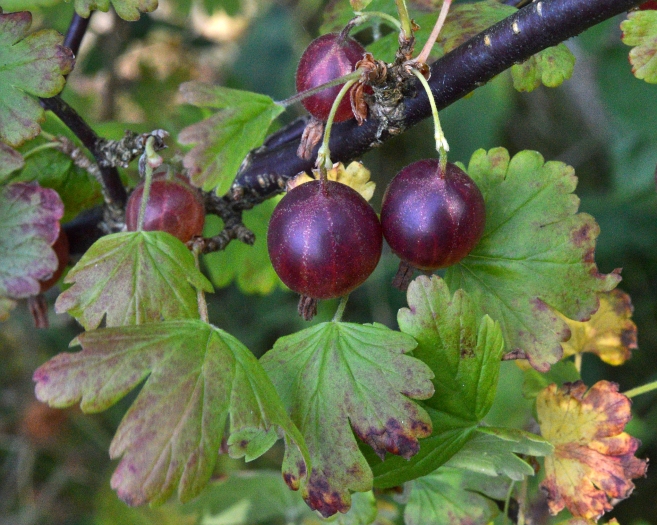Gooseberry
(Ribes uva-crispa)
Gooseberry (Ribes uva-crispa)
/
/

© Ryan Hodnett
CC BY-SA 4.0
Image By:
© Ryan Hodnett
Recorded By:
Copyright:
CC BY-SA 4.0
Copyright Notice:
Photo by: © Ryan Hodnett | License Type: CC BY-SA 4.0 | License URL: http://creativecommons.org/licenses/by-sa/4.0/ | Uploader: ryanhodnett | Publisher: iNaturalist |






















Estimated Native Range
Summary
Ribes uva-crispa, commonly known as gooseberry, is a deciduous shrub native to temperate regions of Europe, the Caucasus, and northern Africa, often found in woodlands, thickets, and hedgerows. It typically grows to a height and width of up to 5 feet (1.5 meters), with spiny branches that deter herbivores. The plant features bell-shaped, pendulous flowers that are usually greenish to pinkish in color and bloom in late spring to early summer. The flowers are modest in showiness, but the shrub is well-regarded for its edible berries, which vary in color from green to red, purple, yellow, or white, depending on the cultivar.
Gooseberries are valued for their tart, flavorful berries that are rich in vitamin C and used in pies, jams, and other culinary creations. They are cultivated both commercially and in home gardens. The shrub is relatively easy to maintain, requiring well-drained soil and full sun to part shade. It benefits from regular pruning to maintain an open, productive form and to reduce disease incidence. Gooseberries can be susceptible to pests like gooseberry sawfly and diseases such as powdery mildew. In some regions, they can become invasive, so gardeners should be aware of local regulations and the plant’s potential to spread.CC BY-SA 4.0
Gooseberries are valued for their tart, flavorful berries that are rich in vitamin C and used in pies, jams, and other culinary creations. They are cultivated both commercially and in home gardens. The shrub is relatively easy to maintain, requiring well-drained soil and full sun to part shade. It benefits from regular pruning to maintain an open, productive form and to reduce disease incidence. Gooseberries can be susceptible to pests like gooseberry sawfly and diseases such as powdery mildew. In some regions, they can become invasive, so gardeners should be aware of local regulations and the plant’s potential to spread.CC BY-SA 4.0
Plant Description
- Plant Type: Shrub
- Height: 3-5 feet
- Width: 3-4 feet
- Growth Rate: Moderate
- Flower Color: N/A
- Flowering Season: Spring
- Leaf Retention: Deciduous
Growth Requirements
- Sun: Full Sun, Part Shade
- Water: Medium
- Drainage: Medium
Common Uses
Bird Garden, Edible*Disclaimer: Easyscape's listed plant edibility is for informational use. Always verify the safety and proper identification of any plant before consumption., Low Maintenance
Natural Habitat
Native to temperate regions of Europe, the Caucasus, and northern Africa, often found in woodlands, thickets, and hedgerows
Other Names
Common Names: Gooseberry, Green Gooseberry, Northern Gooseberry
Scientific Names: , Ribes uva-crispa, Grossularia glandulososetosa, Grossularia grossularia var. reclinata, Grossularia grossularia var. uva-crispa, Grossularia hirsuta, Grossularia intermedia, Grossularia pubescens, Grossularia reclinata, Grossularia spinosa
GBIF Accepted Name: